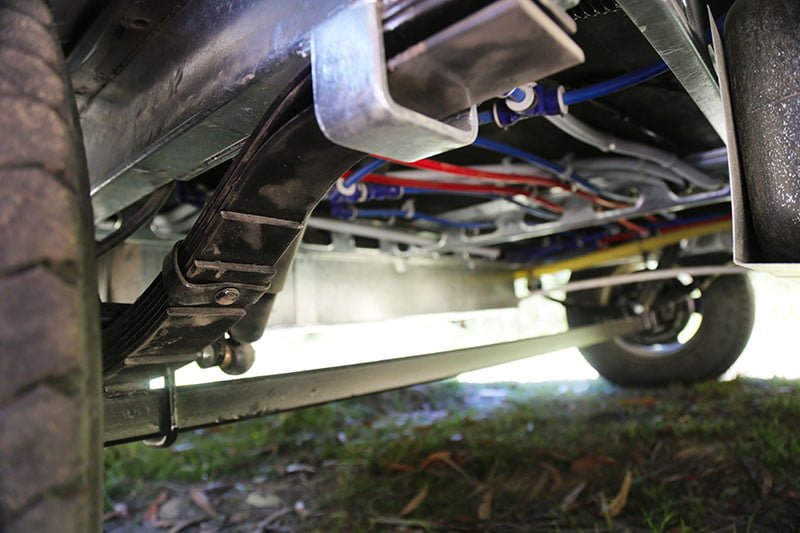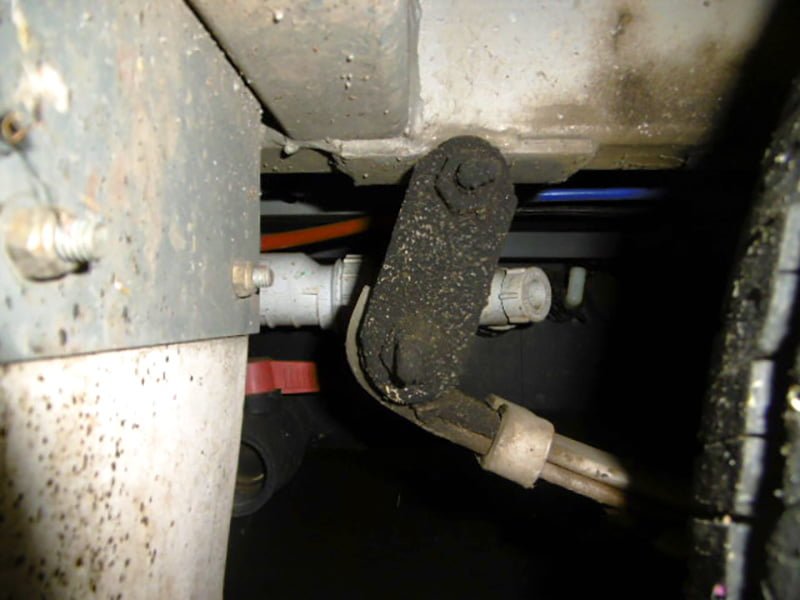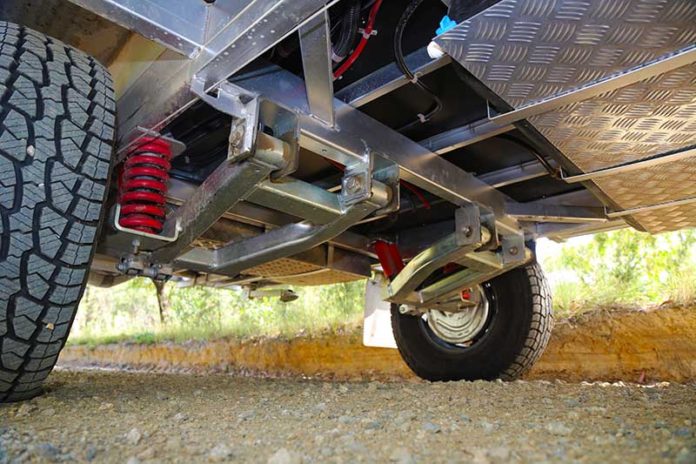The suspension is what rests between the vehicle and the vagaries of the terrain. It cushions the ride, making it more comfortable. But more importantly, the suspension absorbs road shock and prevents these forces from being transmitted to the vehicle and causing damage.
It goes without saying, therefore, that a quality suspension system is vital. But how to choose the right type for your van? And what are the characteristics of a quality system?
Andrew Phillips of The RV Repair Centre and Coronet Caravans has seen his share of dodgy suspension systems, not to mention quality systems that are just in need of maintenance and repair. We asked for his opinion on choosing the right suspension for your van, and how to tell when it’s time to replace or service it.
THE RIGHT SUSPENSION
First and foremost, choosing the right suspension for your van comes down to where you’ll be taking it. It’s unrealistic to think that a standard seven leaf spring beam-axle setup will be effective in extreme offroad conditions. If the Gunbarrel Highway is on the agenda, then a genuine independent suspension with shock absorbers is necessary.
If, however, you’re planning to limit your travels to the bitumen, do you need to fork out the extra dollars for independent suspension when a leaf spring beam axle setup will adequately do the job? No question, a case can be made for on-highway independent suspension systems. The ability for one wheel to move with the lumps and bumps of the terrain, without affecting the other wheel, will naturally make the ride smoother. But this comfort comes at a price. If your pockets are sufficiently deep, then systems such as Vehicle Components’ Cruisemaster GT system, or Al-Ko’s Enduro Touring, would have their benefits.

But what about that ‘grey area’ – semi-offroad caravanning? Loosely defined as national park touring, gravel roads, etc., combined with vanning on the bitumen, semi-offroad caravanning will probably require a suspension upgrade. Again, specialised independent coil setups are available for this sort of caravanning and are widely applauded. But, again, there’s a cost factor.
An alternative is to fit a loadsharing roller-rocker system – a solid all-rounder that should perform well on the bitumen and in semi-offroad situations. (Always remember to lower your tyre pressures to suit, just before turning left down that corrugated bush track.)
SUSPENSION WEAR AND TEAR
Once you’ve decided on the type of suspension that suits your touring intentions best, satisfy yourself that it’s comprised of quality components. A cheap suspension system of unknown or vague overseas origin is probably worth avoiding.
Andrew Phillips reckons much comes down to the quality of the bushes and the shackle bolts, as well as the centre rocker arm if it’s a tandem-axle loadsharing setup. This is because these are the components that keep the suspension moving – they are subject to lots of wear and tear.
“We’ve had some caravans come in with cheap overseas loadsharing suspension and the springs have collapsed, the bushes are worn – everything is flogged out,” he said.
Eventually, individual suspension components, from the bushes to the springs to the shock absorbers (if applicable) will need to be replaced. A worn or faded shock absorber will lose its compression and its ability to control the oscillation of the spring. The van or camper will begin to tow in a less predictable manner.
Coil springs in need of replacement will become compressed – the size of the gaps between the coils will reduce from, say, 20mm when new to 5mm. Is your van leaning to one side? If so, you can bet it’ll be leaning to the side that is carrying the most weight, such as the kitchen with its heavy fridge. In any event, it’s a sure sign that the coils are done.

Leaf springs, however, flatten out. Slipper springs on a single-axle caravan typically need to be replaced when the ‘knuckle’ of the spring (where the spring starts to flatten out, just in front of the spring hanger) starts to rub on the chassis.
If the front or rear shackle plates on a tandem-axle loadsharing suspension are out of vertical alignment when the van is stationary and on even ground, then it’s probably time to replace the springs. If the front spring has lost its original curve, the front shackle plate will tilt backwards, perhaps even at a 45-degree angle. If the rear spring has flattened out, the rear shackle plate will also tilt backwards.
The shackle plate on an eye-eye single-axle leaf spring system will lean forward if the spring is in good condition. If the spring is worn, however, it will lean rearwards. Again, this is because the spring has flattened, effectively increasing the distance between the two eyes.
As for roller-rocker suspension, the loop around the shackle pins and roller at the front or rear will twist around – again due to the worn, flattened spring.
SUSPENSION SUMMARY
To summarise: decide where you want to take your van and choose a reputable suspension system to match. If you’re staying on the bitumen, the simplicity of a beam-axle leaf spring setup has its merits, but an independent system designed just for highway use will provide an even smoother ride for additional outlay.
Beware cheap suspension systems of unknown provenance. They’re cheap because they’re made of inferior components, including the steel.







The worst but unfortunately fairly commonly used tandem axle leaf spring system has the shackle on the rear spring at the leading end of the spring, ie at the centre rocker. With this design, the top leaf of the rear spring is pushing the wheels along, through the pot holes, placing enormous stresses on the top leaf. These systems are the ones that suffer most from spring breakage. Leaf springs are very reliable if the leaf is mounted to the chassis at the leading end so that the spring pulls the wheels along, rather than pushing them.
Whilst I take no issue with this article in general, a major issue with beam axle suspension is not the lack of independence as such – but that there are no well-engineered units on the Australian market suitable for high quality caravan use.
In practice a (single axle particularly) caravan copes with large uni-lateral bumps and depressions by rolling around the tow ball (or whatever hitch is used). As the AL-KO rubber suspension shows, there is not that much need for major spring travel.
Further, as trailing arm independent suspension results in a ground level roll centre – such long travel movement introduces a substantial overturning force – as the centre of gravity is moved sideways.
A beam axle has a roll centre at about rear spring shackle level – not that much lower then the centre of gravity. It is thus fundamentally more stable.
Collyn Rivers
A well balanced van with its leaves appropriately rated and in good condition, with the addition of a pair of sub-$100 shock absorbers fitted, will far outperform an independent suspension system on virtually any road or track you are game enough to take it.
On corrugated roads simply reduce the van tyre pressures as you would your tow vehicles and drive sensibly to suit the conditions.
Sure, leaves will wear and slowly sag over time and need replacing every 40-50,000km, but at AUD$60-$100 for a brand new set of slipper springs (x2 single or x4 tandem) this is way cheaper than unnecessarily expensive independent suspension systems.
Having towed a bog standard single axel Jayco van designed for blacktop only, over more than 40,000km on some of the worst roads this country has to offer (Gibb River,Tanami, Birdsville, Old Savannah Way (Roper to Hells Gate) , Cape York (all multiple times) just to name a few, give me leaf springs any time
We’ve just purchased a New Caravan with Eye to Eye Suspension & intend to use Caravan Parks 95% of the time on Bitumen. Min Gross weight is 2500kg but can go to 3200kg, Tandem Axle Series 19
Crusader (Athos)
We have 3 weeks to finalise our order. Should we look at Independent Suspension & your view, & look at Gas heating? It’s our first Van so would appreciate any advice! Thanks MK
Hi Murray, if you’re planning on mostly travelling on bitumen, leaf suspension should be fine. Independent suspension certainly has its benefits, and if you think you’ll travel any uneven or ungraded roads, I’d certainly consider it. As for gas heating, I don’t have it in my van and have never really missed it; however, that’s not to say you won’t regret not installing it when you’re off mains power and it’s only 5 degrees outside! I’d suggest it is easier to have installed when the van is being fitted rather than later.